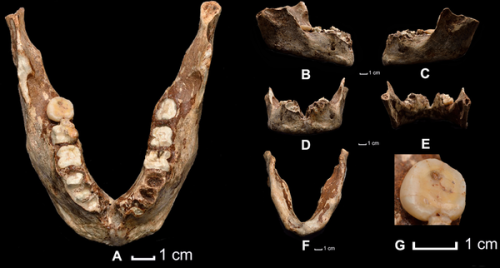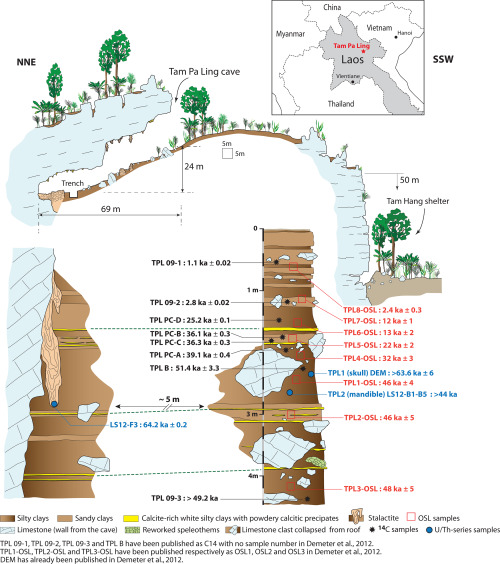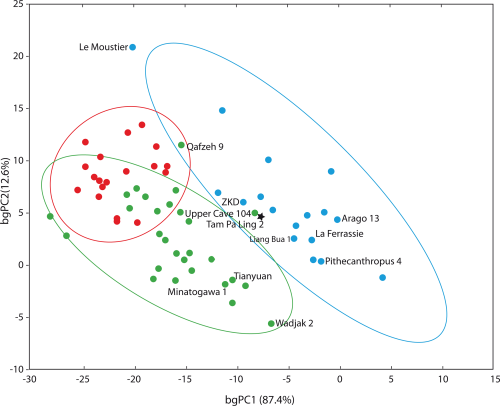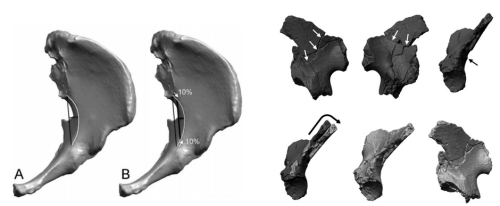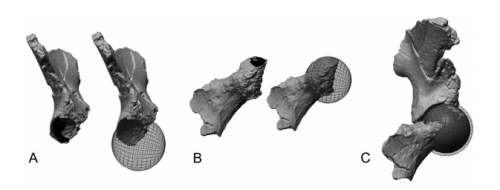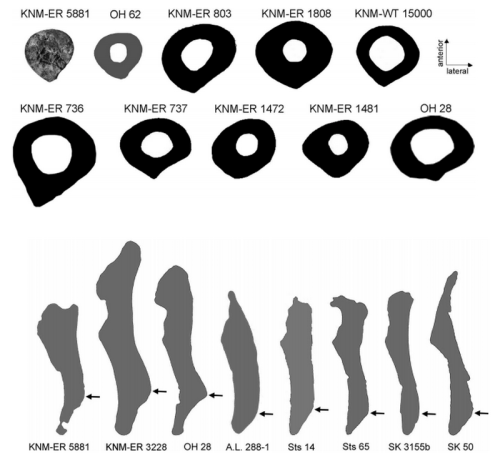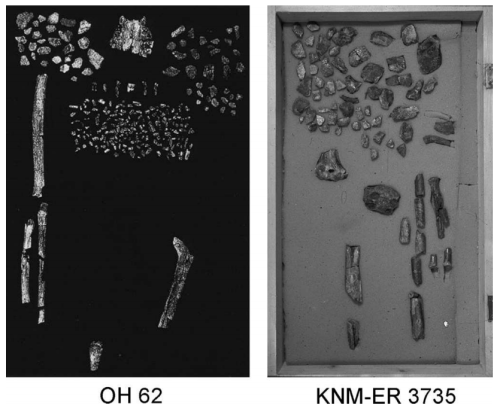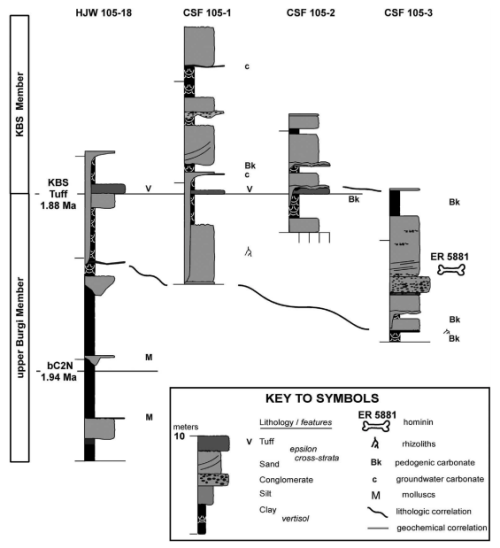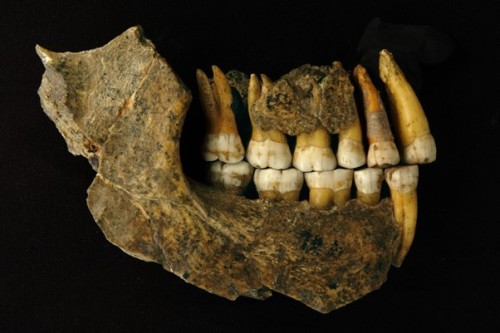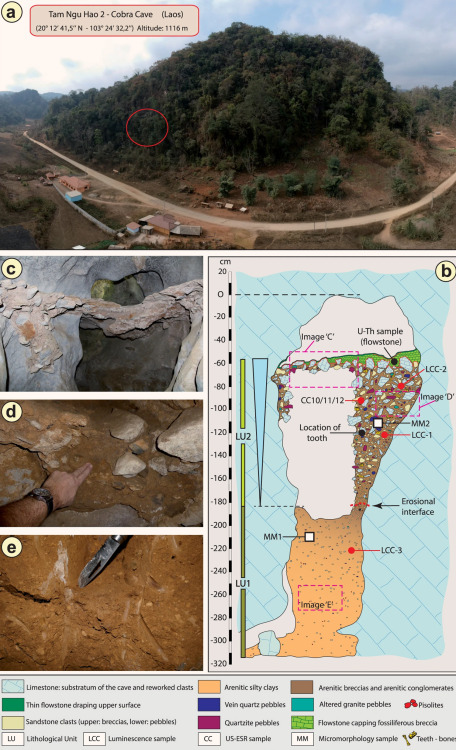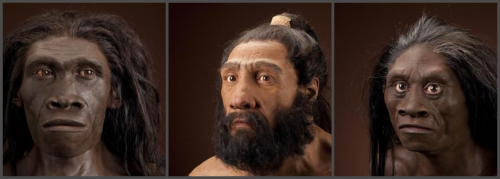#paleoanthropology
- by Fabrice Demeter , Laura Shackelford, Kira Westaway, Philippe Duringer, Anne-Marie Bacon, Jean-Luc Ponche, Xiujie Wu, Thongsa Sayavongkhamdy, Jian-Xin Zhao, Lani Barnes, Marc Boyon, Phonephanh Sichanthongtip, Frank Sénégas, Anne-Marie Karpoff, Elise Patole-Edoumba, Yves Coppens and José Braga
“Little is known about the timing of modern human emergence and occupation in Eastern Eurasia. However a rapid migration out of Africa into Southeast Asia by at least 60 ka is supported by archaeological, paleogenetic and paleoanthropological data. Recent discoveries in Laos, a modern human cranium (TPL1) from Tam Pa Ling‘s cave, provided the first evidence for the presence of early modern humans in mainland Southeast Asia by 63-46 ka. In the current study, a complete human mandible representing a second individual, TPL 2, is described using discrete traits and geometric morphometrics with an emphasis on determining its population affinity. The TPL2 mandible has a chin and other discrete traits consistent with early modern humans, but it retains a robust lateral corpus and internal corporal morphology typical of archaic humans across the Old World. The mosaic morphology of TPL2 and the fully modern human morphology of TPL1 suggest that a large range of morphological variation was present in early modern human populations residing in the eastern Eurasia by MIS 3″ (read more/open access).
(Open access source: PLoS ONE 10(4): e0121193, 2015)
Post link
Associated ilium and femur from Koobi Fora, Kenya, and postcranial diversity in early Homo
- by Carol V. Ward, Craig S. Feibel, Ashley S. Hammond, Louise N. Leakey, Elizabeth A. Moffett, J. Michael Plavcan, Matthew M. Skinner, Fred Spoor and Meave G. Leakey
“During the evolution of hominins, it is generally accepted that there was a shift in postcranial morphology between Australopithecus and the genus Homo. Given the scarcity of associated remains of early Homo, however, relatively little is known about early Homo postcranial morphology. There are hintsof postcranial diversity among species, but our knowledge of the nature and extent of potential differences is limited. Here we present a new associated partial ilium and femur from Koobi Fora, Kenya, dating to 1.9 Ma (millions of years ago) that is clearly attributable to the genus Homo but documents a pattern of morphology not seen in eastern African early Homo erectus. The ilium and proximal femur share distinctive anatomy found only in Homo. However, the geometry of the femoral midshaft and contour of the pelvic inlet do not resemble that of any specimens attributed to H. erectus from eastern Africa. This new fossil confirms the presence of at least two postcranial morphotypes within early Homo, and documents diversity in postcranial morphology among early Homo species that may reflect underlying body form and/or adaptive differences” (read more/open access).
***Open source article for the stuff that’s been in the news a lot lately.
(Open access source:Journal of Human Evolution 81:48-67, 2015 via Academia.edu)
Post link
Belgian Neanderthal remains, including the world-famous Neanderthals of Spy, are thousands of years older than previously assumed. This is the conclusion of an international research team that re-dated the Belgian Neanderthal remains with a new technique. This discovery implies that Neanderthals disappeared from Belgium much earlier than thought and are therefore no longer the youngest Neanderthals in Europe.
The robust Neanderthals dominated Europe and Asia until about 50,000 years ago, until modern humans replaced them. Neanderthals also lived in our regions. Numerous finds in the Walloon Meuse basin bear witness to this. The Neanderthals of Spy, which are kept in the Royal Belgian Institute of Natural Sciences (RBINS), are said to be the youngest in Europe at 37,000 years old. However, a new study led by Oxford University, in which the RBINS also collaborated, has now shown that Belgian Neanderthals disappeared from the region between 44,200 and 40,600 years ago, much earlier than previously assumed. Contamination of the samples would have been the cause of the incorrect dating.
A new method
A multidisciplinary team of archaeologists, geologists, geneticists, and anthropologists re-dated Neanderthal fossils from the Spy cave and two other Belgian sites, Fonds-de-Forêt ((including a femur preserved at the RBINS) and Engis. They used a new dating method in which only the amino acid hydroxyproline is dated. This method limits the risk of contamination by, for example, glue. The results show that Neanderthal remains are older than previously thought, in some cases even 10,000 years older.
For example, the team discovered that a shoulder blade from a Spy Neanderthal (preserved at the ULiège), which had previously yielded very recent data (around 28 000 years ago), was heavily contaminated with bovine DNA. The results suggest that the bone was preserved with an adhesive prepared from bovine bones. ‘These new chemical methods are the only way we can remove contamination from the samples with certainty,’ says Thibaut Devièse (University of Oxford), first author of the study. 'The molecules we date come only from the bone, and not from other sources.’
Cultural transition
'Dating is crucial in archaeology,’ stresses Tom Higham (University of Oxford), who leads the PalaeoChron research project, 'because without a reliable chronological framework, we can’t really understand the relationships between Neanderthals and Homo sapiens. When Homo sapiens moved into Europe 45,000 years ago, Neanderthals began to disappear. These new methods are hugely important to investigate this transition’.
'Dating all these Belgian specimens was very exciting’, says Grégory Abrams, of the Scladina Cave Archaeological Centre in Belgium. 'They played a major role in the understanding and the definition of Neanderthals. Almost two centuries after the discovery of the Neanderthal child of Engis, we were able to provide a reliable age.’
The team is now analyzing archaeological evidence, such as bone tools, to further refine our picture of the cultural transition between Neanderthals and Homo sapiens in our region.
So now Spy’s Neanderthals are no longer the most recent in Europe, but inevitably the young Neanderthal fossils from Gibraltar, Catalonia and south-west France will also be (re)dated using the new technique.
The study was published in the journal PNAS.
Based on the press release from the University of Oxford and the Scladina Cave Archaeological Center.
Post link
New Fossil Discovery Suggests Denisovans Lived in Laos 164,000-131,000 Years Ago
http://www.sci-news.com/archaeology/laos-denisovan-10814.html
Post link

